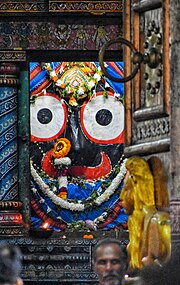

| Odia script | ଦେବଗାନ୍ଧାରୀ |
|---|---|
| Melā | Debagandhari |
| Jati | Sampurna - Sampurna |
| Badi | Sadaja |
| Sambadi | Panchama |
Debagandhari (Odia: ଦେବଗାନ୍ଧାରୀ, romanized: debagāndhāri) is a rāga belonging to the tradition of Odissi music.[1][2][3] Falling under the meḷa of the same name,[4] the raga uses komala dhaibata and is traditionally associated with the karuṇa rasa.[5]
The raga is sampurna or heptatonic in its aroha and abaroha (ascent and descent). Its aroha-abaroha are given below :[6]
Aroha : S R G M P d N S
Abaroha : S N d P M G R S
The raga dwells or does nyasa on the panchama, as per tradition and evokes a pensive mood.[7]
| Oṛiśī Sangīta |
| Odissi music |
|---|

Mahāprabhu Jagannātha
|
| Composers |
| Shāstras |
| Compositions |
| Instruments |
|
|
Some of the well-known traditional compositions in this raga include :